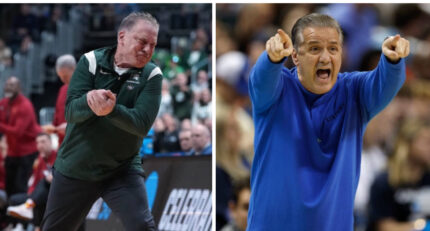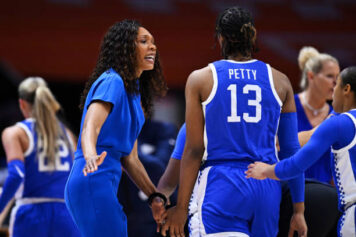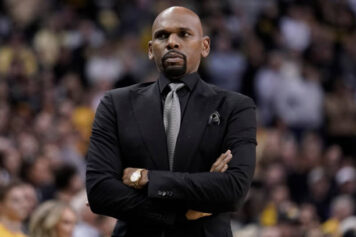Only one eight seed has ever won the national championship and no other team with a seed higher than seventh has ever taken the championship plunge, but Kentucky and UConn are not a pair of rags to riches stories. Everyone remembers Kentucky being ranked No. 1 in the preseason, but UConn was also ranked 20th when the season tipped off.
Kentucky has two factors in its favor on Monday night; talent and destiny. UConn is riding the Wizard of Shabazz, a potential lockdown defense and the emergence of DeAndre Daniels.
On a sidenote: For the last few weeks, I've been comparing the shadow of Kemba Walker hovering over Shabazz Napier to Antoine and Kenny Tyler in The 6th Man. I've been trying to figure out for two weeks who the Washington Huskies beat in the fictional 1997 national championships. Found the movie streaming on HBO Go for some reason. Anyways, turns out the Huskies beat UMass for the title. In reality, John Calipari coached UMass from 1988 to 1996. Two things. A) that means the fictional '97 UMass Minutemen (and Washington) were an example of the Ewing Theory at work because they never reached the title game when Calipari was coach and B) this foreshadows a UConn win tonight.
Ok maybe not, but it's been equally inexplicable explaining UConn's tear through the tournament field. Kentucky's is a bit more plausible. The talent has always been there. it was just a matter of discipline and coalescing as a unit.
The scales are even. Using common foes as a barometer of success, it’s even more confusing.
Florida was 3-0 vs. Kentucky in the regular season. UConn was 0-2 vs. Louisville and was drubbed by 33 on March 8th.
Conversely, UConn handed Florida two of its three losses. Kentucky was 2-0 against Louisville.
Not only have UConn and Kentucky broken amateur and professional brackets alike, they’ve also shattered KenPom’s rigid statistical analysis.
Since KenPom began recording adjusted offensive and defensive ratings in 2002, no team has won the championship without finishing in the top 25 in both areas.
Shabazz Napier, Tyler Olander and Niels Giffey have been here before. They were where Kentucky’s freshman are now a freshman on UConn’s 2011 national championship squad. However, they were bit players on that team. Giffey’s sharpshooting has been non-existent in the tournament, but he’s still shooting 48.3 percent from deep for the season. It’s incredible that they’ve reached this point with their best shooter, who benefits from Napier’s pick and roll action missing in action.
Against Florida, he did most of his work cutting to the hoop, but if he rediscovers his stroke, Kentucky may have a problem on their hands.
The showdown between Julius Randle and Daniels will be the prime matchup to watch. Daniels is a Transformer forward who score above the rim inside or pick-and-pop outside where he’s shooting 40 percent from behind the arc. Randle doesn’t have great lateral quickness to defend on the outside, however, Daniels can be erratic.
Napier is a “strike anywhere” match, but his teammates are a potential brushfire from the three-point arc.
On the flipside, Kentucky’s trees Randle, Dakari Johnson, Alex Poythress and Marcus Lee have given their past tournament foes fits inside. Yet, UConn’s length allowed them to hold Michigan State to just six points in the paint and had Florida flustered.
For weeks, Calipari has been discussing a mysterious tweak that changed the entire season. He’s hidden it better than KFC’s secret recipe.
According to Calipari, it’s a change that he’s disappointed he didn’t make earlier this season.
“When you figure out what it is, you’re going to say, ‘You should have done it earlier,’ ” Calipari said. “I’m here to tell you I should have.”
If you just quipped that the tweak was a pay raise for his freshman stars ala Blue Chips, you'd be wrong.
College hoops analyst Tim Welsh told the New York Times that he believes Calipari’s adjustments come down to him basically doing more coaching.
“It seems like John’s tightened up things,” Welsh told the Times on Sunday. “He’s been more controlling, calling plays. I think he’s taken a lot of the thinking out of the game.”
The popular theory is that Calipari simply slowed down the Wildcats offensive pace by nearly six possessions per game.
Conversely, Kevin Ollie’s adjustments from a game-to-game basis have been visible for all to see. One year after Trey Burke proved the value of a point guard en route to the national championship, Napier has been just as vital for the Huskies. His backcourt mate Ryan Boatright has been equally important.
Their defense has held Florida, Michigan State, Iowa State and Villanova to 40 percent shooting from the field and Boatright's hyperactivity has been a key component to their strangling backcourt on-ball pressure. If there’s one thing we’ve learned in recent years, it’s that defense wins championships.
Kentucky is ranked 6th in offensive efficiency, but are 44th on the defensive side. UConn is 10th offensively, but if they get hot from behind the arc look better than the 37th ranked offensive team. That’s why I’m picking UConn. Kentucky has high school McDonald’s All-Americans in droves, but UConn has grown men on the court.



